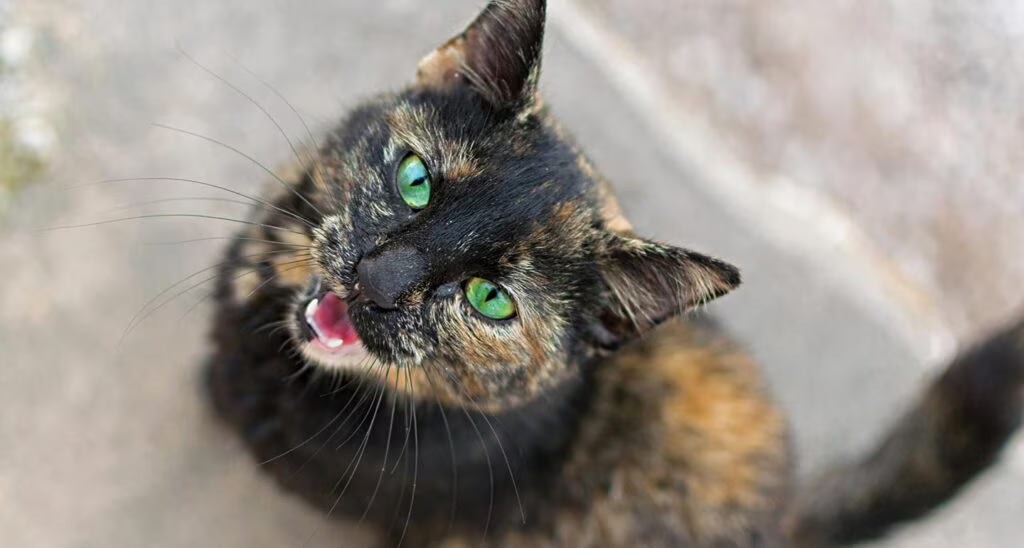Cats are often considered mysterious creatures, yet one of their most expressive traits is their voice. From soft trills to persistent yowls, cats use meowing as a vital tool to communicate with humans. Interestingly, adult cats seldom meow at one another in the wild; this behavior is mainly used to communicate with humans.
Understanding why cats meow, what their different sounds mean, and how to respond effectively can strengthen your bond with your feline companion and ensure their well-being.

Why Do Cats Meow?
Meowing is not just random noise; it is an evolved form of communication designed to get our attention. Kittens use meowing to attract their mother’s attention, whereas adult cats have evolved this behavior mainly to interact with humans. Here are the most common reasons behind their vocalizations:
Learn more about: Catnip for cats
Seeking Attention or Companionship
Cats often meow simply to say, “Notice me.” This can occur when they want to be petted, played with, or simply acknowledged. Some cats form strong attachments to their owners and may vocalize more when left alone for long periods.
Hunger or Requests
A classic reason behind meowing is to ask for food. Many cats learn to vocalize when they hear food packaging, see their bowl, or at specific times of day when they expect feeding.
Greetings
Short, friendly meows are often a cat’s way of saying hello when you return home or when they encounter you in another room. These meows tend to be brief, cheerful, and inviting.
Stress, Anxiety, or Environmental Changes
Situations like moving to a new home, adding another pet, or changing daily routines can lead to increased vocalization in cats. Cats rely heavily on familiarity, and disruptions may lead them to meow more frequently as a sign of unease.
Medical Concerns
Continuous or unusual meowing can indicate that a cat is experiencing discomfort or illness. Conditions such as hyperthyroidism, dental pain, urinary tract infections, or cognitive decline in older cats often manifest as changes in vocal behavior. Any abrupt change in your cat’s meowing patterns should be evaluated by a veterinarian.
Breed and Personality
Some cats are naturally more talkative. Breeds like Siamese, Oriental Shorthairs, and Burmese are known for their high levels of vocalization. However, individual personality plays just as significant a role, some cats are inherently chatty, while others remain quietly observant.
Decoding Different Types of Meows
Cats make a variety of vocal sounds, with each one conveying a distinct message. While interpretation depends on context and your cat’s personality, here are some common vocal patterns:
- Short, high-pitched meow: Friendly greeting or mild request.
- Extended, drawn-out meow: Persistent demand, often for food or attention.
- Low-pitched yowl: Complaint, frustration, or discomfort.
- Chirps or trills: Often used to express excitement or invite interaction.
- Nighttime caterwauling: Common in unspayed females in heat, elderly cats with cognitive issues, or cats seeking companionship during their nocturnal activity periods.
Is Excessive Meowing a Problem?
Occasional meowing is normal, but sudden changes, excessive noise, or unusual vocal tones should not be ignored. Signs that warrant closer attention include:
- Sudden increase in frequency or volume
- Meowing exclusively at night or in distress
- Especially when combined with changes in appetite, litter box use, or overall behavior.
- Senior cats exhibiting confusion or disorientation alongside vocalization
- Consulting a veterinarian promptly can help rule out health problems and offer reassurance.
How to Respond to Your Cat’s Meowing
Managing and interpreting meowing involves understanding its root cause. Here’s how to approach it effectively:
Identify the Context
Observe when and where your cat meows. Does it coincide with mealtime, your arrival home, or specific environmental triggers? Context is key to understanding motivation.
Avoid Reinforcing Unwanted Meowing
If your cat constantly meows for attention or food, avoid responding right away. Rewarding quiet, calm behavior teaches them that silence earns rewards.
Establish Routine
Cats thrive on predictability. Regular feeding, playtime, and sleep schedules reduce anxiety-driven vocalizations.
Provide Mental and Physical Stimulation
Boredom can lead to excessive meowing. Offer toys, puzzle feeders, climbing structures, and interactive play to keep their minds and bodies engaged.
Address Medical Concerns Promptly
When in doubt, seek professional advice. Early intervention for underlying health issues prevents minor problems from becoming serious.
Support Senior Cats
For aging cats with nighttime confusion or increased vocalization, consider nightlights, calming pheromone diffusers, or a consistent bedtime routine to provide comfort.
Frequently Asked Questions (FAQs)
Cats are naturally most active at dawn and dusk. Nighttime meowing may signal hunger, boredom, or loneliness, and in older cats, it can also be associated with cognitive changes. Establishing a bedtime routine and providing evening play sessions can help reduce nocturnal vocalizations.
While you cannot completely eliminate meowing (it’s their form of communication), you can manage it. Avoid reinforcing excessive meowing and reward calm, quiet behavior instead. Enrichment activities also reduce attention-seeking vocalizations.
Yes. A sudden change in vocal behavior can indicate pain, illness, or stress. Arrange a veterinary appointment to check for any underlying health concerns.
Absolutely. Breeds like Siamese and Oriental cats are genetically predisposed to vocalize more frequently. Personality also plays a major role—some cats are simply more talkative.
Look for accompanying symptoms like lethargy, changes in appetite, weight loss, vomiting, or altered litter box habits. These signs, combined with unusual vocalizations, require veterinary attention.
Conclusion
Meowing is not just a random noise; it is a sophisticated form of communication that cats use to interact with humans. By paying attention to when, how, and why your cat meows, you gain valuable insight into their needs and emotions.
Whether they are hungry, happy, stressed, or unwell, each meow carries meaning. Responding with patience, care, and understanding not only strengthens your bond but also ensures a healthier, happier life for your feline friend.


Pingback: Do Cats Need High protein? Expert Guide & Tips -